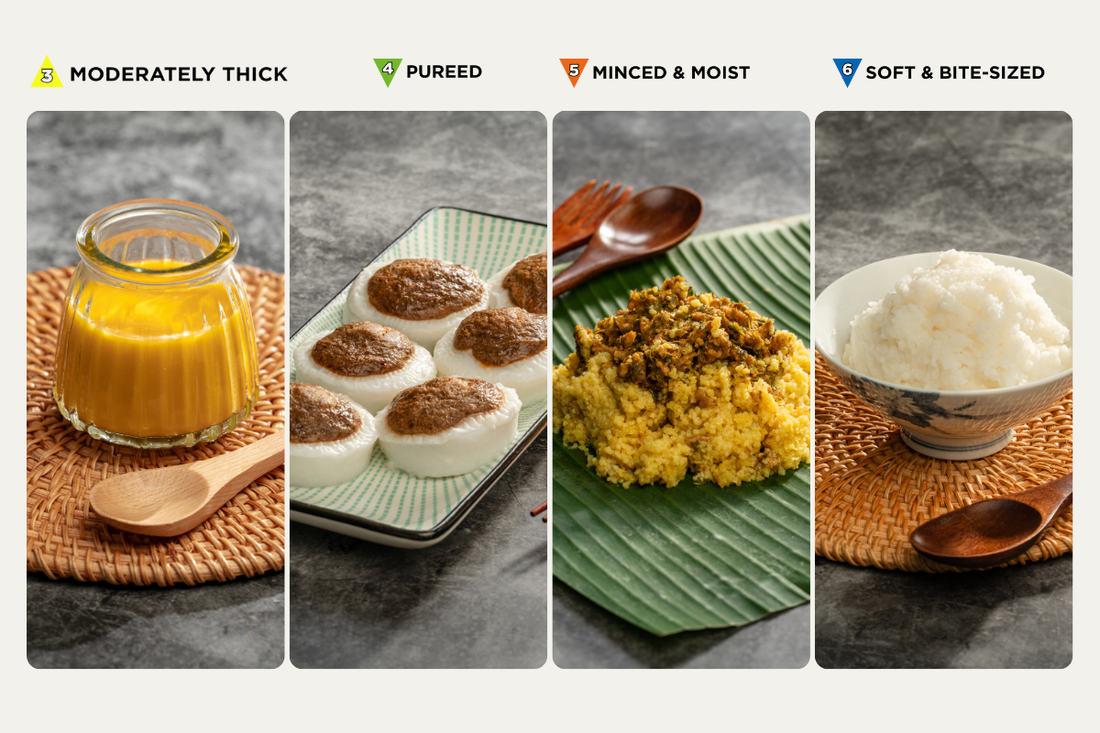IDDSI: A Guide to Safe and Nutritious Eating for Individuals with Swallowing Difficulties
Share
Swallowing difficulties, or dysphagia, can significantly impact a person's quality of life. For individuals facing these challenges, eating can become a source of anxiety rather than enjoyment. To address this issue, the International Dysphagia Diet Standardisation Initiative (IDDSI) was established to create a clear, standardized framework for food texture and liquid viscosity, ensuring safer and more enjoyable dining experiences. In this blog post, we’ll explore what IDDSI is, its importance, and how it benefits individuals with swallowing difficulties.
What is IDDSI?
Launched in 2013, IDDSI is a global initiative aimed at standardising diet textures and liquid consistencies for individuals with dysphagia. The IDDSI framework comprises a set of descriptors and testing methods, categorizing food and drinks into specific levels based on their texture and viscosity. This standardization helps caregivers, healthcare providers, and food manufacturers create and provide meals that are safe and appropriate for those with swallowing difficulties.
The IDDSI Framework
The IDDSI framework consists of eight levels, ranging from Level 0 to Level 7:
-
Level 0: Thin Liquid - Clear liquids that flow easily, such as water or broth. These liquids do not form a cohesive mass.
-
Level 1: Slightly Thick Liquid - Liquids that are thicker than water but still pourable, such as some juice drinks or milkshakes.
-
Level 2: Mildly Thick Liquid - Liquids that can be sipped through a straw but have more body than Level 1, such as yogurt drinks.
-
Level 3: Liquidised - Foods that are blended to a smooth consistency, resembling a thick, pudding-like texture.
-
Level 4: Pureed - Foods that are smooth, soft, and cohesive, requiring no chewing. Examples include pureed fruits or vegetables.
-
Level 5: Minced and Moist - Foods that are finely chopped and moist, making them easier to swallow without the need for chewing, such as minced meat or finely diced vegetables.
-
Level 6: Soft and Bite-Sized - Soft, tender foods that can be easily mashed with a fork and cut into bite-sized pieces.
-
Level 7: Regular Food - Regular textured foods that do not require any modifications.
Importance of IDDSI
-
Safety: The IDDSI framework is designed to reduce the risk of choking and aspiration, which can lead to severe health complications. By standardizing food textures and liquid consistencies, individuals with dysphagia can consume meals that are safe and appropriate for their swallowing abilities.
-
Improved Quality of Life: Eating should be an enjoyable experience. The IDDSI framework allows individuals with swallowing difficulties to participate in social meals with family and friends, reducing feelings of isolation and frustration.
-
Guidance for Caregivers and Professionals: IDDSI provides clear guidelines for caregivers, healthcare providers, and food manufacturers, ensuring that everyone involved in meal preparation understands the dietary needs of individuals with dysphagia.
-
Customizable Options: The framework encourages innovation in food preparation and encourages the creation of a variety of safe and delicious meals, catering to the diverse tastes and preferences of individuals with swallowing difficulties.
How to Implement IDDSI in Meal Preparation
-
Assessment: Begin by assessing the individual's swallowing abilities. Healthcare professionals can provide guidance on which IDDSI levels are appropriate.
-
Food Preparation: Use the IDDSI guidelines to prepare foods at the correct texture level. This may involve blending, pureeing, or chopping foods to meet the individual's needs.
-
Labeling: Clearly label meals with the corresponding IDDSI level to inform caregivers and individuals about the food's consistency.
-
Education: Educate caregivers and family members about IDDSI standards to promote awareness and understanding of the dietary needs of individuals with swallowing difficulties.
The IDDSI framework is a vital resource for individuals with dysphagia, offering a structured approach to safe and nutritious eating. By promoting standardization in food textures and liquid consistencies, IDDSI helps improve the quality of life for those with swallowing difficulties, allowing them to enjoy meals with confidence and comfort. As caregivers and food providers, understanding and implementing IDDSI can make a significant difference in the dining experiences of individuals facing these challenges.
For more information about IDDSI and its guidelines, you can visit IDDSI’s official website.





